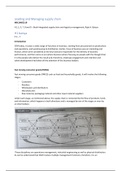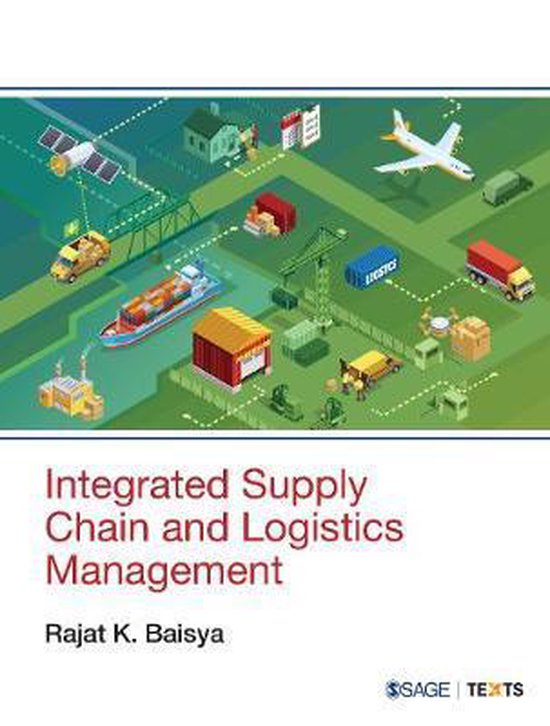Leading and Managing supply chain
MSCLMSC119
H1, 2, 5, 7, 8 and 9 – Book Integrated supply chain and logistics management, Rajat k. Baisya
H1 baisya
P2–7
Introduction
SCM today, it covers a wide range of functions in business, starting from procurement to productions
and operations, and warehousing to distribution. Earlier, focus of business was on marketing and
finance, which were considered as the key functions responsible for the delivery of business
performance, and then came an era where business where focusing on people with the thought that
it is the people who deliver the result and, therefore, employee engagement and retention and
talent development had taken all the attention of the business leaders.
Fast moving consumer goods (FMCG)
Fast moving consumer goods (FMCG) such as food and households goods, it will involve the following
stages;
- Customers
- Retailers
- Wholesalers and distributors
- Manufacturers
- Raw material, packaging material and other input material suppliers
Under each stage, as mentioned above, the supply chain is connected by the flow of products, funds
and information, which happens in both directions and is managed by one of the stages or even by
an intermediary.
These disciplines are operations management, industrial engineering as well as physical distribution.
As can be understood that SCM involves multiple management functions, therefore, it is an
,interdisciplinary subject requiring knowledge of many other functions. Separate stream, which can
be broadly classified as follows;
- Sourcing and procurement and supply chain
- Materials management
- Logistics and distribution management
The procurement function occupied a predominant position in the supply chain for the reason that it
impacts both cash flow and profitability of the business and requires to be managed efficiently.
,H2 Baiysa
P 10 -29
Introduction
SCM as we understand now covers a very wide range of activities, including procurement,
warehousing, transport and logistics, inventory management, production, demand management,
distribution and customer services. It, thus, assumes great importance in managing the business in
terms of cross-functional expertise, efficiency and effectiveness.
Scope of SCM
The three main streams of integrated SCM are as follows;
1. Sourcing, procurement and supply management
2. Materials management and demand management
3. Logistics and distribution management
A customer will be buying the product from the end selling point and that could be a retail store in
the neighbourhood.
Sourcing and procurement are important areas of SCM. Materials management and logistics and
distribution are put together.
Evolution of SCM
There are five major movements or major led initiatives that we can observe at the evolution the
SCM as we know it now.
Creation era - > integration era -> Globalization era -> Specialization era I -> Specialization era II
Key objectives and challenges of supply chain integration
, The primary objective of all supply chains has to be to maximize the overall value generated in the
chain which would also mean to generate supply chain surplus which can be defined as follows;
Supply Chain Value = Customer Value – Supply Chain Cost
The customer value is in fact the price a potential customer is willing to pay for the product offering,
which depends not only on the product type, quality and benefits that it offers to the target
customers but also on how the product has been positioned in the customers minds and how it is
promoted and marketed.
Objectives and challenges of SCM
The key objectives that reflect the performance of SCM in a business world would ultimately depend
on achieving the cost reduction objective and to achieve that we have many challenges.
- Reducing total cost
- Increasing customer service level
- Reducing the impact of bullwhip effect
- Utilizing the organizational resources in a better way
- Effectively and proactively responding to changes in the marketplace
These strategic drivers illustrate the opportunities and challenges associated with SCM integration
1. Supply chain strategies; Push, pull and push pull systems
2. Demand Driven strategies
3. Effective distribution strategies
Pull strategies are always better in the sense that in a pull strategy, the demand is a managed from
the point of view of the real- term demand of the customers and it is the task of the marketers to
create the customer demand.
Role of SCM
The primary role of SCM is to optimize the organizational resources to maximize the sales and profit
by servicing the real-term customer demand. In this task, SCM primarily performs the following
activities;
- Communicating the customers demand from the point of Sale POS to the supplier
- Physical flow process that engineers the movement of goods
- Optimizing the organizational resource to satisfy the customers demand
Why is SCM so important?
In today’s business, sourcing is done from places and factories where it costs the least and is most
efficient in terms of quality and delivery.
SCM is managed to provide multiple benefits to the business, which include the following;
- Improving efficiencies from procurements, distribution and logistics





